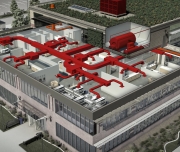An energy saving, stormwater managing, attractive alternative to traditional roofing surfaces is the planted roof. Reflective roofs or “cool roof” systems can also help save on cooling costs. While making changes to the roof, consider installing a solar hot water heating system. Solar hot water heaters, common in both commercial and residential settings, can save significantly on energy bills and frequently have a quicker payback period than photovoltaic panels. An even better way to save on water heating costs is to heat less water: low-flow shower heads and high-efficiency faucets with sensor controls save both energy and water. The reduced demand at the fixture paired with the free heat from the sun may allow you to buy a smaller boiler and pumps, saving on both first costs and operating costs.
System Bundling
When specifying or replacing a particular HVAC component, consider bundling that component with other related building equipment and strategies. Building technologies work best when they work together. A sustainable building can operate more efficiently and cost less when the impacts of systems on each other are considered. The system bundling section can be leveraged to further understand whole building synergies and explore examples for ideas on what technologies might best be bundled together.
Solid Waste and Indoor Environmental Quality (IEQ)
If used inside, ensure that solid waste compactors are supplied with an adequate amount of fresh outside air and vented directly to the outside and not recirculated within the building’s HVAC system. All equipment used for the management of solid wastes must be cleaned and maintained on a quarterly basis at a minimum to ensure smooth operation of ongoing waste management services for the building. Special care must be taken with outdoor installations to reduce/eliminate pests and unauthorized usage by non-building management personnel. Odors of any sort (i.e., cleaning solvents or air fresheners) may provide an unpleasant odor that may cause headache or nausea by property occupants. To decrease unwanted pests and control odors, food waste collection for offsite composting needs to be in properly contained, well-ventilated areas, and regularly picked up for disposal.
Optimize Indoor Air Quality and Energy Efficiency
The quality of air that we breathe should be a concern for everyone within the building. Luckily there are simple measure that can be taken to ensure this air is free of harmful airborne particulates, mold spores and gases. While increasing the ventilation rates of the HVAC system is the easiest way to replenish indoor air, it can use additional energy. Install CO2 sensors at strategic locations and tie these to fan controls to ensure that that proper ventilation is available, but only when needed. Optimizing both IAQ and energy efficiency involves cognizant collaboration between HVAC and IEQ components.
Integration of low-emitting materials and entryway dirt capture systems with a comprehensive Green Cleaning and IEQ maintenance plan will help prevent IAQ contaminants from being introduced to the space.
Staged Approach to Upgrades
Looking at fixing up the whole building, at once or in parts? If so, the order in which you make these upgrades will affect your long term energy and water savings as well as your up-front costs. The ENERGY STAR Building Upgrade Manual walks you through a five-stage approach to minimize cost and maximize effectiveness. These stages include retrocommissioning, lighting upgrades, supplemental load reductions, air distribution system upgrades, and HVAC upgrades. Read more in the Building Upgrade Manual![]() .
.
Building Automation
Building automation consists of a computer-based system with measurement sensors and control devices for components such as HVAC equipment and lighting. Monitoring and controlling systems around and within a building allow building owners to track energy and address areas of concern, providing opportunities for improved equipment and energy efficiency. Monitoring ventilation helps maintain healthy indoor environments. It is important to employ re-commissioning and continuous commissioning practices to ensure the building systems are properly calibrated and maintained. Investing in a building automation system can realize significant energy savings if equipment is performing as intended and building systems synergies are considered. HVAC building automation is inter-related with energy efficiency, continuous commissioning, systems level metering and lighting control. Consider investing in these HVAC specific systems:
- Occupancy sensors save energy from the operation of HVAC systems by turning off some HVAC functions when no occupants are within the building zone. The HVAC sensors are often combined with lighting and security control systems to display continual energy use data for verification and occupant education purposes.
- Multi-zone HVAC systems reduce energy consumption while providing effective thermal conditions such as temperature, humidity and air velocity for occupants. Consider dividing space into multiple and manageable zones according to use requirements, size, and location. One solution for providing quality thermal and ventilation comfort is enhanced ventilation terminal control system with multi-zone VAV box terminal controls and individual airflow controls.
- Demand-control ventilation provides just enough outside air to meet the health needs of the occupants. Outside air is expensive to condition, so during times where few people are in a space (as determined by CO2 monitors), less outside air is delivered. These systems work particularly well with conference or training rooms, where occupancy fluctuates greatly throughout the day.





